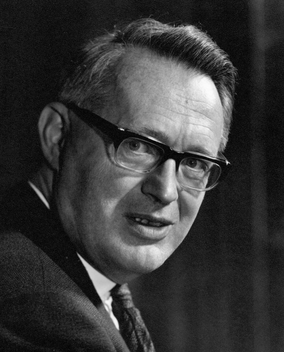David Rees (mathematician) facts for kids
Quick facts for kids
David Rees
|
|
|---|---|

Portrait by Godfrey Argent
|
|
| Born | 29 May 1918 Abergavenny, Wales
|
| Died | 16 August 2013 (aged 95) |
| Alma mater | University of Cambridge |
| Known for |
|
| Spouse(s) |
Joan S. Cushen
(m. 1952) |
| Awards |
|
| Scientific career | |
| Institutions | |
| Doctoral advisor | |
| Doctoral students |
|
David Rees (born May 29, 1918 – died August 16, 2013) was a brilliant British mathematician. He was a professor of pure mathematics at the University of Exeter. He led the Mathematics Department at Exeter from 1958 to 1983. During the Second World War, Rees played a very important secret role. He worked on cracking the Enigma code at Bletchley Park.
Early Life and School
David Rees was born in Abergavenny, Wales. His father was a corn merchant. David was the fourth of five children in his family. Even though he was sometimes sick and missed school, he did very well. He completed his early education at King Henry VIII Grammar School.
University and War Work
David Rees won a special scholarship to attend Sidney Sussex College, Cambridge. He studied mathematics and finished his degree in 1939. After university, he first worked on a type of math called semigroup theory. Some important ideas in this field, like the Rees factor semigroup, are named after him.
Later in 1939, World War II began. David Rees was asked to join the war effort at Bletchley Park. This was a top-secret place where British codebreakers worked. He was part of a team in a building called Hut 6. Here, they worked to decode messages sent by the German Enigma machine. He helped with one of the first successful decodes using a special method called the Herivel tip.
Rees later moved to the Enigma Research Section. This group successfully broke the code used by the Abwehr Enigma. He also worked in the Newmanry section. This is where the very early Colossus computer was built. These computers helped crack even more complex German codes.
After the War
After the war ended, David Rees continued his career in mathematics. In 1945, he became a lecturer at Manchester University. Then, in 1948, he moved to the University of Cambridge. He became a Fellow at Downing College in 1949.
He then changed his main area of research to commutative algebra. This is another advanced area of mathematics. In 1954, he worked with another mathematician, Douglas Northcott. Together, they developed new ideas that were very important in this field.
In 1958, David Rees and his family moved to Exeter. He became the head of Pure Mathematics at the University of Exeter. In 1959, the University of Cambridge gave him a special Doctor of Science (DSc) degree.
Awards and Family
David Rees received many awards and honors for his work. In 1949, he was made an Honorary Fellow of Downing College, Cambridge.
In 1968, he was chosen to be a Fellow of the Royal Society (FRS). This is a very high honor for scientists in the United Kingdom. In 1993, the University of Exeter also gave him an Honorary Doctor of Science degree. That same year, he won the Pólya Prize from the London Mathematical Society. This is a major award for mathematicians.
In 1952, David Rees married Joan S. Cushen. She also became a Senior Lecturer in Mathematics at Exeter. They had four children:
- (Susan) Mary Rees FRS, who became a Professor of Mathematics at the University of Liverpool.
- Rebecca Rees.
- Sarah Rees, who became a Professor of Pure Mathematics at Newcastle University.
- Deborah Rees.

